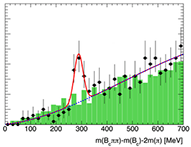Research Notes

Invariant mass distributions of the reconstructed Bc±→J/ψπ± candidates in 7 TeV data (top) and in 8 TeV data (bottom). The data are represented by the points with error bars (statistical only). The solid line is the projection of the results of the unbinned maximum likelihood fit to all candidates in the mass range 5620–6820 MeV. The dashed line is the projection of the background component of the same fit.
Observation of an Excited B±c Meson State with the ATLAS Detector
A particle discovered by the UNM Large Hadron Collider group, led by Dr. Sally Seidel, has been selected as the Editor's Highlight by the Physical Review. This work was part of the PhD efforts of graduate student Rui Wang.
A search for excited states of the B±c meson (a hadronic subatomic particle), is performed using 4.9 fb-1 of 7 TeV and 19.2 fb-1 of 8 TeV pp collision data collected by the ATLAS experiment at the LHC. A new state is observed through its hadronic transition to the ground state, with the latter detected in the decay B±c→J/ψπ±. The state appears in the m(B±cπ+π-)-m(B±c) - 2m(π±) mass difference distribution with a significance of 5.2 standard deviations. The mass of the observed state is 6842 ± 4 ± 5 MeV, where the first error is statistical and the second is systematic. The mass and decay of this state are consistent with expectations for the second S-wave state of the B±c meson, B±c(2S).
For more information see the article at: Observation of an Excited B±c Meson State with the ATLAS Detector.
Department of Physics and Astronomy
The University of New Mexico
Physics, Astronomy, and Interdisciplinary Sciences building (PAÍS)
210 Yale NE
Albuquerque, NM 87106
505-277-2616
505-277-1520 fax
